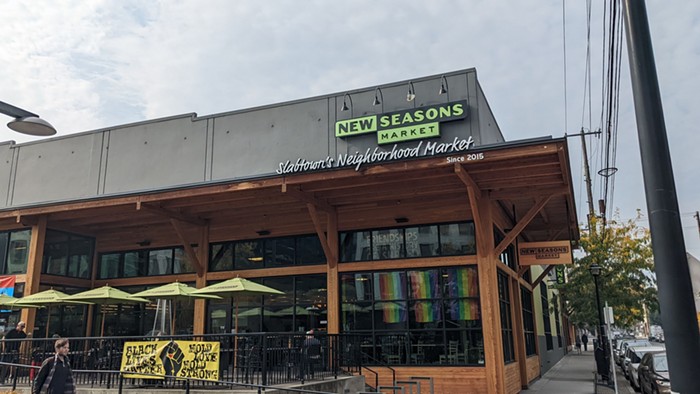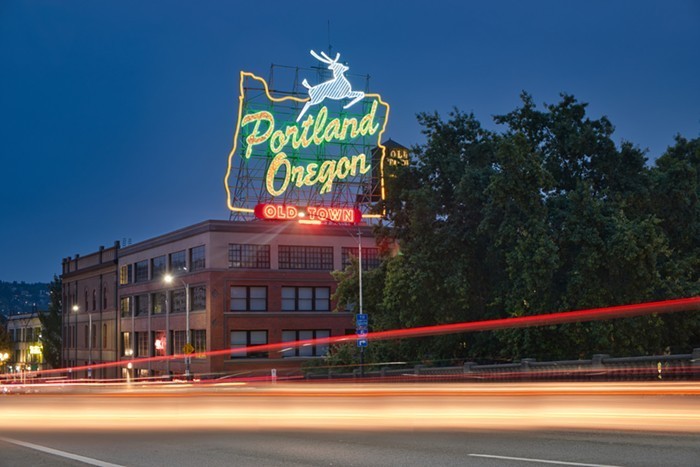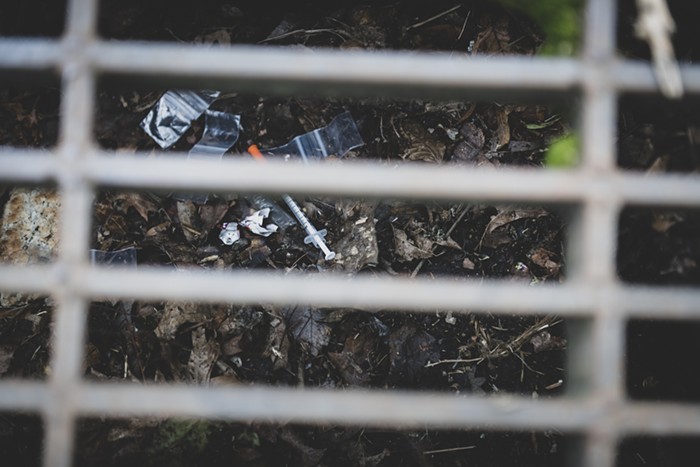
Portland Public School (PPS) representatives reiterated their skepticism of the Interstate 5 expansion project, as well as their distrust of the Oregon Department of Transportation (ODOT), in an intergovernmental meeting Thursday evening.
ODOT representatives presented the latest updates of the Rose Quarter Project—ODOT’s nearly $800 million plan to add two new lanes to a 1.7 mile stretch of I-5 in Northeast Portland to reduce congestion and fender benders—to the PPS Board of Education members, giving the PPS representatives an opportunity to voice their concerns and ask questions of the project leaders.
This was the first meeting between PPS and ODOT since a newly discovered planning map revealed that ODOT wants to take over a portion of Harriet Tubman Middle School’s grounds—which are situated next to the proposed I-5 expansion area—and build a sound barrier to mitigate noise pollution on the school property as part of the freeway expansion. The planning map, obtained by advocacy group No More Freeways through a public records request in April, revealed that the sound barrier would be less than 25 feet from the school building. When the plans were discovered, No More Freeways held a rally against ODOT’s encroachment on the school, drawing several hundred community members out in opposition of the plan.
“We know that this is going to have an intolerable impact for our students,” Amy Kohnstamm, a PPS board member, told OPB at the rally.
During the meeting, Rose Quarter Project Director Megan Channell said ODOT’s planners are reviewing the possibility of widening the freeway in the other direction to avoid bringing the interstate closer to the school. Channell stressed that the project design is only 20 percent complete and still has time to change, but the public records showed that ODOT has included this encroachment of the school property in its planning since 2018. PPS board members, who have been asking for information on how the expansion would impact the school for years, expressed their distrust of the transportation department during the meeting.
“How are we supposed to trust [ODOT] when those kinds of things keep happening, not in the past, but in the current?” board member Scott Bailey asked the ODOT representatives.
Bailey was referencing the perceived lack of transparency and commitment to promises ODOT has maintained around the project, particularly around two key issues: air quality and ODOT’s commitment to restorative justice.
The I-5 expansion’s impact on air quality has been contested since the project’s inception in 2010. According to Channell, the Rose Quarter Project will decrease air pollution because it addresses the stop-and-go traffic that occurs during peak congestion times. By improving traffic flow with the addition of auxiliary lanes, ODOT claims the air quality in the surrounding area will improve slightly.
But, a 2018 report commissioned by ODOT found that the project won’t improve the congestion issues on the 1.7 mile stretch of I-5. So, when ODOT released an environmental assessment of the project in 2019 that stated the freeway widening would improve air quality, there was justified skepticism. Right after the environmental assessment was released, an analysis by a city of Portland think tank found that the project would actually increase greenhouse gas emissions by 4.7 to 7.9 thousand tons because of induced demand—the observed phenomenon that when you build space for more cars, more cars will start using that space. That’s when calls for an environmental impact statement—a more rigorous study of the environmental implications of the project—from community members, freeway opponents, and local officials started to grow.
Instead of an environmental impact statement, ODOT commissioned a peer review of its previous environmental assessment, which found the assessment to be sound. No More Freeways is still pushing for an environmental impact statement via a lawsuit launched in April of this year.
But, as PPS board member Julia Brim-Edwards pointed out in Thursday’s meeting, the peer review was led by a former director of ODOT. Brim-Edwards also raised concerns about the limited scope ODOT was viewing air quality through.
“The statement that this doesn't have a significant impact on Harriet Tubman Middle School, it doesn't ring true,” said Brim-Edwards, referencing not just the conflicting environmental findings, but the original impact of building I-5 next to the middle school in the 1960s.
Harriet Tubman Middle School existed before I-5 was built, and it wasn’t until ODOT constructed the corridor during the freeway era of the 60s that Harriet Tubman students and the surrounding community were exposed to dangerous pollutants. A 2018 study from Portland State University found the school had higher levels of air pollutants than surrounding urban areas, so much so that it recommended outdoor student activities like recess be limited and not occur during high-traffic times. Brim-Edwards urged ODOT to not view the air quality impacts through the limits of this current project, but as an issue that ODOT has been responsible for since the interstate was first built 60 years ago.
“The standard that is being set is not a standard that's based on the health of our students, but an arbitrary [question of], ‘Is it slightly better, or going from horrible to less horrible?’” Brim-Edwards said.
While the board members remained unconvinced that the air quality around Harriet Tubman would improve due to the project, they opted to turn their questioning towards a larger theme: restorative justice.
When this stretch of I-5 was originally constructed in the late 1950s and 60s, the City of Portland leveled hundreds of Black-owned homes in the Albina neighborhood, causing mass displacement of Portland’s Black community and destruction of a Black economic sector of the city. ODOT is hoping to address some of these systemic harms by including the historic Albina community in the planning process and asking how the expansion project can also serve as an investment in the community. Currently, ODOT plans to do that by prioritizing hiring Black-owned construction companies to complete the project and build freeway covers that can double as community spaces for the disrupted neighborhood.
Notably, ODOT developed these investments after government officials like Mayor Ted Wheeler and then-PBOT City Commissioner Chloe Eudaly offered to support moving forward without an environmental impact statement if ODOT committed to including restorative justice and investing in rebuilding the community as part of the widening project.
Originally, ODOT was partnering with Albina Vision Trust (AVT), an organization committed to rebuilding the Albina community, but the group pulled its support of the widening project in June 2020, partially because the freeway covers ODOT planned for would not be stable enough to support community center buildings that AVT wanted. ODOT has since created a Historic Albina Advisory Board, a group of community members who have been impacted by I-5’s original construction, to “elevate voices in the Black community” in the project’s development process.
“We realize we can't dig up the freeway and give everybody their homes back, but there are opportunities that can help us build generational wealth in line,” said Ericka Warren, a member of the advisory board whose grandparents’ home was destroyed during the original construction of the freeway, addressing board members Thursday. “You have a group of invested, community leaders who lived, walked, and breathed Harriet Tubman who are conscious and are working alongside with you.”
Several PPS board members questioned if true restorative justice for Harriet Tubman students—40 percent of whom are Black—would be to relocate the school to a less polluted PPS building, possibly Jefferson High School. When asked if the project would consider funding that potential move, Channell said that the project does not have the funds to assist PPS with any relocation of the school. The project has nearly doubled in budget since its inception, from $450 million to nearly $800 million. There are still design concepts in question that could push the project closer to $1 billion.
During the public comment period, Joan Petit, a white parent whose Black children attended Harriet Tubman, also questioned ODOT’s concept of restorative justice.
“ODOT wants to double down on the harm to this community, with an unnecessary freeway expansion,” Petit said. “Even worse, they are calling this restorative justice, as if paying Black people to further destroy their communities, to hurt Black children, is some kind of reparations and is anything other than cynical exploitation. Is the health and wellbeing of my Black children irrelevant to ODOT?”
By the end of the meeting, it was clear the PPS board members weren’t sold on ODOT’s stated commitments to a climate conscious and equitable project. Channell said that ODOT is committed to regain the community’s trust through their actions going forward.
ODOT is set to make a decision on whether the I-5 expansion will move towards Harriet Tubman Middle School or not, as well as if they can provide more stable freeway covers to support buildings, by fall of this year. Construction on the project is set to begin late 2023 or early 2024.



















